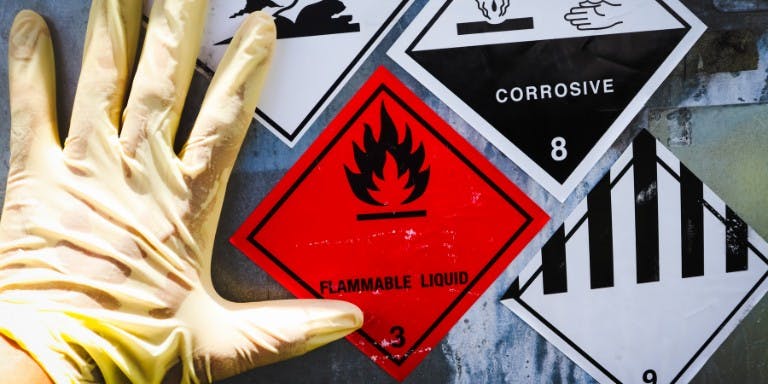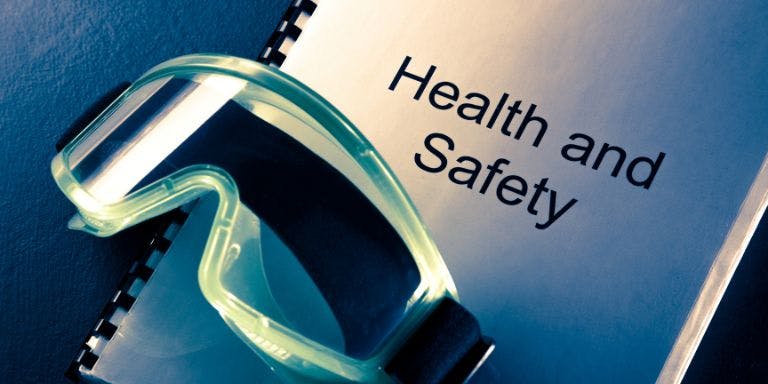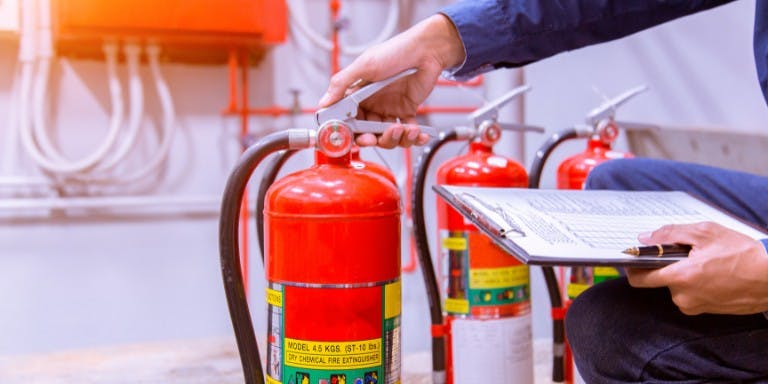First published on Thursday, June 4, 2020
Last updated on Tuesday, January 14, 2025
Jump to section
- What is manual handling?
- What are your legal responsibilities for manual handling at work?
- What are the risks of poor manual handling?
- Manual handling training courses
- Best practices for manual handling in the workplace
- Guidance to give your employees for manual handling tasks
- Implement a manual handling policy
- Get help for safe manual handling in the workplace
Employees of most businesses today have to deal with some kind of manual handling in the workplace. It doesn’t always have to involve heavy lifting, so you should assume that a lot of your staff are exposed to tasks related to manual handling on a regular basis.
When an employer doesn’t do what is reasonably practicable to create a safe workplace, including training its staff on proper procedures, manual handling can pose a serious health and safety risk.
Recent HSE and RIDDOR data shows that almost a fifth (17%) of non-fatal injuries sustained at work were related to handling, lifting or carrying items, so it’s a danger that can’t be ignored—but it can be prevented.
Read on as we uncover covering everything you need to know about manual handling in the workplace. From common risks to creating policies for staff and providing health & safety training to keep them safe.
What is manual handling?
Manual handling is defined in the HSE’s Manual Handling Operations Regulations 1992 (MHOR) as:
“Any transporting or supporting of a load (including the lifting, putting down, pushing, pulling, carrying or moving thereof) by hand or bodily force.”
The load being handled can be an object, such as a box of files or a crate of products, or even an animal or a person. Obviously, loads differ dramatically between industries, so it’s important to take a broad brush stroke to manual handling—it could be a more common occurrence in your business than you realise.
If your employees are expected to be lifting, lowering, pulling, pushing or carrying anything using the power of their bodies alone, it’s your responsibility as their employer to make sure they’re aware of and trained in the risks involved.
What are your legal responsibilities for manual handling at work?
In the UK, you’re expected to be on top of all the manual handling risks your employees face on a regular basis, so the MHOR 1992 sets out three measures for you to follow as an employer:
Avoid hazardous manual handling operations so far as is reasonably practicable
Assess any hazardous manual handling operations that cannot be avoided
Reduce the risk of injury so far as is reasonably practicable
The Health and Safety at Work Act 1974 also dictates that employers should provide:
“Systems of work that are, so far as is reasonably practicable, safe and without risks to health” for all staff."
By law, you must ensure that workers aren’t at risk of injury or worse if they are asked to complete manual handling tasks as part of their jobs.
Of course, the element of risk can’t be 100% removed from every single scenario, but you are required to take every necessary step to reduce it to a minimum to keep your staff safe.
Your first port of call should be to conduct a risk assessment of your workplace—start taking action now with our five-step guide here and don’t forget to involve your workforce in the assessment so you can get a full picture of what they handle on a day-to-day basis.
If you need immediate assistance with anything to do with risk assessments or safety in the workplace, get in touch via our 24/7 health & safety advice line today.

What are the risks of poor manual handling?
An Health and Safety Executive (HSE) stats suggest that more than a third of injuries in the workplace are due to manual handling—often because the people doing the handling aren't following the correct procedures.
The most common injuries are musculoskeletal disorders (MSDs), including pain or injury sustained to the arms, legs or joints. Injuries to the back or shoulders are common, too, while repetitive strain injuries (RSI) can also be linked to work-related upper limb disorders (WRULDs).
It's important for employers to consider things like task rotation or staff swap-over to reduce the risks of these kinds of injuries. The more you can do to prevent manual handling injuries, the less the impact will be on both your employees and your business.
The health and safety of your staff is first and foremost, but the knock-on effects of sick leave, for instance, can damage the productivity and efficiency of your business operations, so it’s in everyone’s interest to reduce risk.
Manual handling training courses
If manual handling is required as part of your business operations, you should have a manual handling course as part of your inductions for new staff, along with regular updates or reminders for existing staff.
You can dive into BrightSafe’s e-learning course on manual handling awareness to tick this off your list. It’s RoSPA-assured and CPD-certified, available for your staff to complete as part of your BrightSafe package. With an online e-learning course it has never been easier to provide your staff with the relevant and necessary health & safety training, information, and guidance.
The course covers the essentials including:
The health & safety legislation associated with manual handling
What manual handling is
The role of manual handling risk assessments
How to identify manual handling injuries and other concerns
The risk of poor manual handling on the human spine
The correct manual handling lifting techniques
Plus, the BrightSafe health & safety software includes a range of documents for everything to do with manual handling in the workplace, including an awareness poster, an information checklist and a toolbox talk. So, you can rest assured knowing that your staff are well-informed about manual handling in the workplace.
Best practices for manual handling in the workplace
If manual handling must happen, despite making every effort to avoid hazardous tasks, training and preparing your staff is an absolute must.
Take steps to avoid injury or damage—always try to:
Plan the lift and consider where you or your employee will be placing the load—remove all obstructions
Ensure that only trained and briefed staff assist with the manual handling
Consider whether more than one person will need to handle the load
Separate the load into smaller, more manageable, lighter objects where possible
Choose the flattest walking route, even if it's a longer route
Clear the route of any potential trip and slip hazards that would increase the risk of falls
Plan rest stops along the way to change grip or position and recover energy
Set up a clear and safe area for the lowering and unloading
It’s best practice to include the weight of the objects in your risk assessments before any lifting occurs, too—think about who’ll be doing the manual handling and control the risk as well as you can.
Do they have a preexisting condition that will put them at greater risk? Is the load awkward, sharp or fragile? Can it be lifted by a team of people rather than an individual, especially if it needs to travel a fair distance?
Consider the nature of the route, too—are stairs required? Is the lighting sufficient? Are there any tight corners? Might they come across any slippery floors?
Conduct a thorough risk assessment every time any manual handling task is required and review it at least annually or following an incident (near miss) or an accident.
Guidance to give your employees for manual handling tasks
It’s not all down to you to ensure a safe working environment—staff who are trained in health & safety can also make every effort to reduce risk.
Advice for any manual handling task:
Warm up with a few stretches (we know it’s not a park run, but it can seriously help)
Stand close to the object with your feet apart (roughly the distance between your shoulders)
Bend your knees, not your back, when reaching down and lifting up
Grasp the object firmly and gauge the weight and integrity of the load before lifting the full weight
Raise your head and shoulders and then lift with your legs
Advice for moving the load:
Keep the heaviest side close to your body
Point your feet in the direction you're moving
Do not twist your back or lean to the sides where possible
Keep your shoulders level and facing in the same direction as your hips
Look ahead, not down at the load, as often as possible
Only change grip during a rest stop
Once you lower the object, adjust it as necessary to reposition by sliding or turning it—don’t rush into completing the task simply to move onto the next one, as this can increase the risk of injury.
If you have access to lifting aids like forklift trucks, hoists (hand- or electric-powered), conveyors, use them for heavier loads to reduce the risk involved. You might find that you can only use a lifting aid in addition to handling, rather than as a replacement. Where possible, use lifting aids like dolly boards, trolleys, pallets or sack trucks to make life easier for yourself.
The Provision and Use of Work Equipment Regulations 1998 (PUWER) dictate that only people who are trained to do so should use lifting aids in the workplace—employers are required to prevent usage for anyone without the necessary training.

Implement a manual handling policy
It’s hopefully clear by now that you need a dedicated policy in place if any of your employees are expected to perform manual handling at work.
The nature of a manual handling policy will change from business to business and industry to industry, so be sure to conduct a thorough risk assessment and talk to your staff to define yours. Make sure it contains guidance on risk assessment, the usage of specific equipment, the necessary training and any relevant handling techniques and procedures.
Implementing the policy isn’t a one-off task either—make sure everyone knows about it and remembers it by conducting yearly reviews and updating and republishing your manual handling policy if necessary.
Get help for safe manual handling in the workplace
To maintain a safe workplace for your staff, it’s crucial that you invest in a health & safety approach that everyone can understand and follow.
BrightHR’s health & safety software is primed to help you implement the right approach at your business—you can book a free demo of it today to see how it can improve your manual handling operations.











